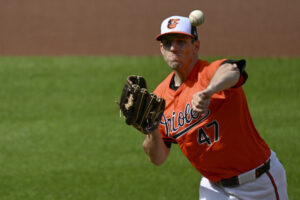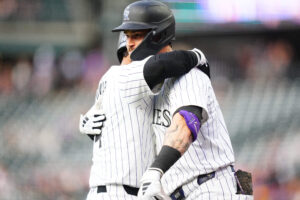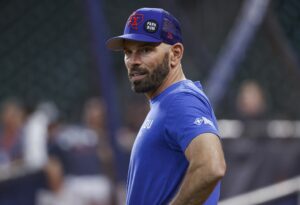In an offseason that was packed with important players switching teams — Albert Pujols joining the Los Angeles Angels, Jonathan Papelbon signing with the Philadelphia Phillies, and Yu Darvish entering the MLB – it was a trade that may have been the steal of the 2012 winter meetings. On December 17, 2012, the New York Mets sent righthanded pitcher and reigning Cy Young Award winner R.A. Dickey, along with catchers Josh Thole and Mike Nickeas to the Toronto Blue Jays. They got four players back in the trade: catchers Travis d’Arnaud and John Buck, right-handed pitcher Noah Syndergaard and outfielder Wuilmer Becerra.
While there was some hype around Syndergaard as a first-round pick, most expected him to take some time to get to the majors — it was d’Arnaud who was the big name in the deal. That has certainly changed in the last five years, eight months, and six days.
Revisiting the R.A. Dickey (now Noah Syndergaard) Trade
Why the Mets Made the Trade
Though they had a team option on Dickey for 2013, they weren’t getting closer to a deal with him, who told the New York Daily News the Mets first offer was a two-year, $14 million deal. There had only been three reigning Cy Young-winners traded before Dickey, but the Mets weren’t willing to spend the extra money to keep him around. His eventual contract with the Jays was a three-year, $29 million deal – a 38% increase in average annual salary.
Why the Blue Jays Made the Trade
In the bloodbath that is the American League East, the Jays saw not just a pitcher who would help anchor their rotation along with Josh Johnson and Sean Marcum, but a Cy Young winner who could help push them past the Yankees and Red Sox into the playoffs. To top it off, they didn’t have to give up a ton to get him. While d’Arnaud was the headline player in the deal – he was the number 11 prospect according to MLB Pipeline — Buck, Syndergaard, and Becerra were mostly throw-in players. Syndergaard was the number 95 prospect on the MLB.com 2012 pre-season rankings, and though he had moved up to 83 at the time of the trade, the Jays did not think he could help them soon enough.
The Impact for the Jays
For the first nine years of R.A Dickey’s career — before he left for the Mets — he struggled in the American League. That didn’t change when he joined the Blue Jays. In his first year with Toronto, the Nashville native had a 4.21 ERA – nearly a run and a half higher than his Cy Young season just a year earlier. Dickey also gave up career highs in earned runs and home runs.
Josh Thole continued his career with the Jays where he left it with the Mets. Thole was a player who was never quite good enough for the MLB, but was a solid Triple-A level player. In the 2013 season he played 45 games for the Jays. He hit .175 with a .497 OPS, which contrasted starkly with his .322 average in 41 games with their AAA affiliate. He would split time between the MLB and Triple-A for the Jays until 2016 when his contract was not renewed. Thole has not played in the majors since. Mike Nickeas didn’t have an MLB at bat for the rest of his career.
The Impact for the Mets
Travis d’Arnaud hit a speed bump in 2013 when he suffered a fractured foot, but he returned from the injury and made the jump to the majors. Though he hit just .202 with a single home run and three doubles in 31 games, he hit .304 with 10 extra-base hits in 19 games for Triple-A Las Vegas. D’Arnaud has had health issues throughout his career but has maintained his spot on the Mets since the 2013 season.
John Buck didn’t have a major impact in 2013. He was shipped out of New York near the end of the season to the Pittsburgh Pirates. The catcher hit .215 with a .652 OPS and 15 home runs in 101 games as the primary starter for the Mets.
Noah Syndergaard
Ok, here’s where things get interesting. Noah Syndergaard rocketed up the MLB.com Pipeline rankings following his move to the Mets. He went from ranked 83 to 29 by the 2013 preseason and was 12 by the end of the 2013 season. He went 3-3 with a 3.11 ERA in Advanced-A St. Lucie before being called up to Double-A, where the righty pitcher stepped his game up further. Syndergaard was 6-1 with a 3.00 ERA and 69 strikeouts in 54 innings for AA Binghamton.
The rest is history. Syndergaard made his MLB debut in 2015 and pitched better than he had the year before after an up-and-down 2014 in Triple-A. He was 9-7 with a 3.24 ERA, 166 strikeouts, and was fourth in the Rookie of the Year Award voting. The Mansfield, Texas native has played in an All-Star Game, been to a World Series, and is 33-21 with a 3.00 ERA, 1.13 WHIP and 10.1 strikeouts per nine innings in his major league career. ‘Thor’ has transformed the trade from the R.A Dickey trade to the Noah Syndergaard trade.
Wuilmer Becerra was just 17 when the trade happened, and has fluctuated between high and Single-A since 2015. The right fielder had a solid year last season at Advanced-A St. Lucie where he hit .267. However, he has little power in his swing, hitting just 22 home runs in nearly 500 games in the minors. It seems unlikely he will play in the majors, but at 23 years young, it’s hard to say impossible.
Who Won?
Is this even a real question? No, it’s not even close. The Mets won the trade and they won it by a mile. Even if d’Arnaud didn’t play a single game in the MLB, what Noah Syndergaard has done alone is enough to swing this deal in the Mets favour. Dickey’s terrible time as a Jay would make most trades for him hard to justify, let alone the one that actually happened. METS METS METS.
Another Trade?
While Jacob deGrom and Syndergaard were the targets of trade rumours earlier in the season as a chance to rebuild quickly, prior to the trade deadline the Mets front office told SNY’s Andy Martino they had moved away from the idea. This means that Syndergaard is unlikely to be moved this season, but if the Mets get an offer similar to the haul that the Tampa Bay Rays got for Chris Archer, it would be hard to turn down.
Main Photo:
Embed from Getty Images






